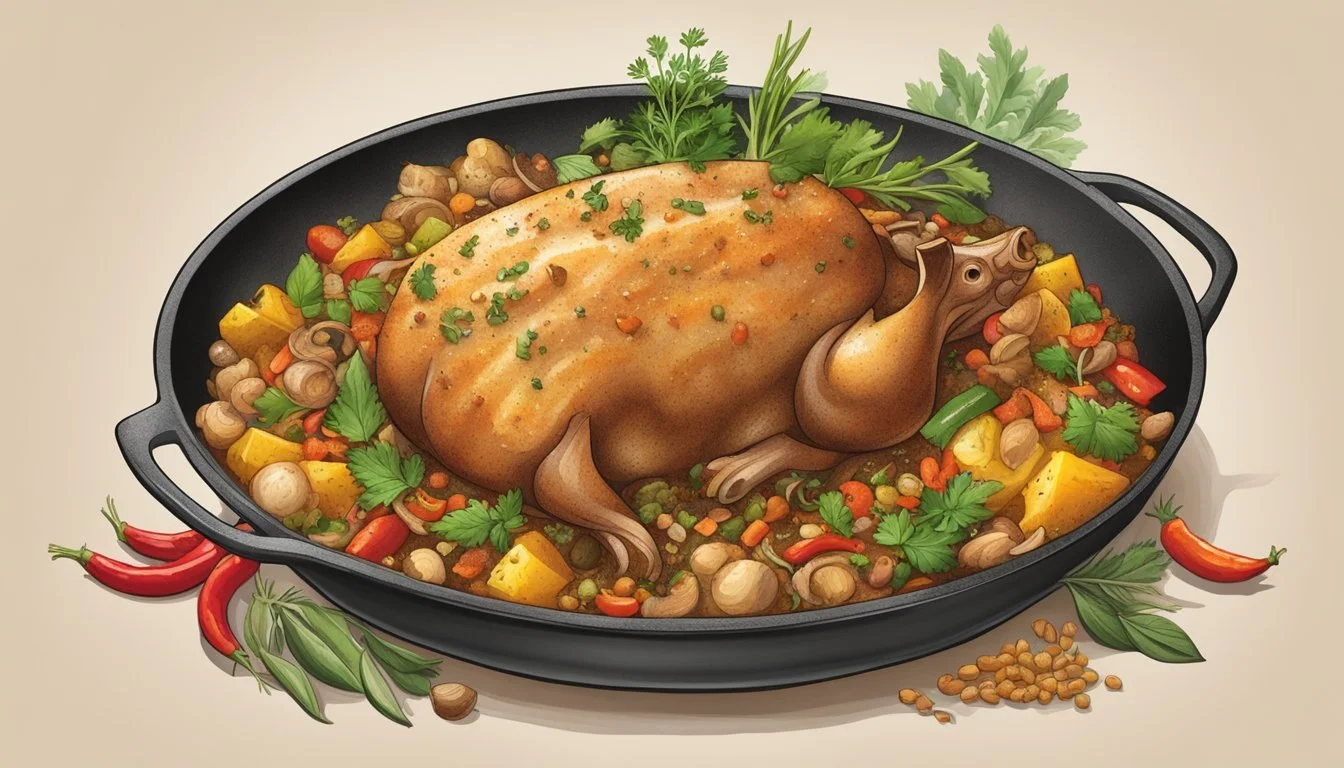Crispy Fried Pig Tails
Savoring a Delightfully Unconventional Snack
Crispy fried pig tails are gaining popularity as a unique and delectable appetizer in the culinary world. They offer a novel twist on traditional pork dishes, standing out for their rich flavor and satisfying texture. When prepared correctly, the exterior of the pig tails becomes wonderfully crisp, while the meat inside remains tender, providing a contrast that can be a delightful surprise to those trying it for the first time.
The cooking process for pig tails generally involves two main steps: frying to achieve a golden-brown crust and then braising or further cooking to ensure the meat is thoroughly cooked and infused with flavor. It's common to season pig tails with a blend of aromatic ingredients such as garlic, onion, and soy sauce. The addition of spices, wine, or vinegar can complement the fatty richness of the pork, creating a balanced and tasty dish.
As an appetizer, crispy fried pig tails serve as a conversation starter, presenting an opportunity for diners to explore less familiar parts of the pig that are often overlooked. They are versatile enough to be paired with a variety of sauces and can be a compelling addition to a gourmet menu or a casual gathering. This speaks to the growing trend of rediscovering traditional foods and elevating them with modern cooking techniques.
Origins and Cultural Significance
Crispy fried pig tails are an intriguing appetizer with roots that tap into culinary tradition and resourcefulness. They transform a less commonly used part of the pig into a delicious dish.
Historical Background
Historically, pig tails were among the parts of the pig that were less favored for consumption in mainstream Western cuisine. However, they have been utilized thoroughly in various cultures due to the ethos of nose-to-tail eating, which aims to honor the animal by minimizing waste. This principle led to the innovation of dishes like crispy fried pig tails, which have been enjoyed for generations in some regions. Traditionally, the cooking process involves boiling the tails first to tenderize the meat, then frying them until they achieve a crispy exterior.
Cultural Variations
Across different cultures, the pig tail can take on various roles within the culinary spectrum. In the Southern United States, pig tails are often braised or smoked, imbuing the meat with a deep, barbecue flavor. These methods are a testament to the region's rich history of slow-cooked meats. The tail forms part of the soul food tradition, emblematic of survival and making do, which resonates with the area's historical context.
In contrast, in Chinese cuisine, pig tails are typically stewed with soy sauce and spices, reflecting the diverse palette of flavors prevalent in Asian cooking practices. The resulting dish offers a balance of savory meat with a subtly spiced sauce, showcasing another perspective on how to savor this unique cut.
Selecting Quality Pig Tails
Selecting high-quality pig tails is critical for a delicious crispy fried appetizer. A careful approach at the butcher shop and an understanding of freshness and cuts can make all the difference.
Butcher Shop Guidelines
When seeking pig tails, it is paramount to frequent a reputable butcher shop. Knowledgeable butchers usually source from trusted farms, ensuring that the pig tails are of premium quality. Patrons should inquire about the origin of the meat and choose shops that forge direct relationships with local farms.
Source: Local farms or respected suppliers.
Butcher Knowledge: A good butcher can provide details about the pig tail's quality and preparation.
Recognizing Freshness
The freshness of pig tails is indicated by a few tell-tale signs. They should have a healthy, pinkish color and be free from any unpleasant odors. The flesh should be firm to the touch, and there should be no signs of discoloration or sliminess, which are indicators of spoilage.
Color: Healthy pink hue.
Odor: No off smells.
Texture: Firm and not slimy.
Understanding Size and Cuts
Pig tails come in various sizes and cuts, which can impact the cooking process and the final dish. Consumers should look for tails that are evenly cut and sized to ensure uniform cooking. Larger tails typically have more meat and may require a longer cooking time, while smaller tails could be more suitable for quick frying.
Size: Choose based on the cooking method and serving preference.
Cuts: Evenly cut tails for consistent cooking.
By adhering to these guidelines, chefs and home cooks can select the best pig tails for an appetizing and crispy fried dish.
Preparation Techniques
In this section, we delve into the preparation techniques for creating crispy fried pig tails, focusing on cleaning, trimming, and marinating, as well as the braising process which is pivotal to achieving the desired tenderness before frying.
Cleaning and Trimming
Prior to any seasoning or cooking, pig tails require thorough cleaning. They should be rinsed under cold water to remove dirt and debris. Using a sharp knife, any excess fat and hair are trimmed off, ensuring a cleaner taste and better texture in the final dish.
Marinating for Flavor
Marinating introduces a depth of flavor to the pig tails. A marinade typically consists of a blend of soy sauce, wine, and various herbs and spices relevant to the desired flavor profile. The pig tails should be fully submerged in the marinade for several hours, which not only infuses them with flavor but also begins the tenderizing process.
Best Practices for Braising
Braising the pig tails is a step that requires finesse. The following are essential points for best practices in braising:
Submerge the marinated pig tails in a pot with a mixture of water and additional flavoring agents like garlic and onions.
The liquid should be brought to a boil and then lowered to a simmer, allowing the pig tails to cook until they are tender.
By adhering to these techniques, the pig tails are prepared to achieve the perfect balance between a crispy exterior and a tender interior once fried.
Cooking Methods
To achieve the ultimate crispy fried pig tails, chefs incorporate a variety of cooking techniques including braising, deep frying, and oven baking, ensuring the skin turns delightfully crisp while the meat remains tender.
Braising Pig Tails
Braising is an essential first step that involves slowly cooking pig tails in a flavorful liquid. In this process, the pig tails are submerged in a mixture of water, seasonings like garlic, onion, and soy sauce, and sometimes wine, which infuses them with deep flavors. The slow cooking renders the connective tissues, resulting in tender meat that is ready for the subsequent frying or baking to add that much-desired crispness.
Frying to Perfection
Following the braising process, pig tails are thoroughly patted dry and then deep-fried in oil at a temperature around 350°F. This high-heat cooking method crisps up the skin quickly, creating a golden brown exterior. Care must be taken to not overcrowd the frying vessel to ensure even cooking and to maintain the oil's temperature for the best results.
Oven Baking for Crispiness
An alternative to deep frying, oven baking provides a less labor-intensive method to achieve a crispy texture. Preheated at temperatures between 375°F to 425°F, the oven bakes the braised pig tails until their skin crackles and turns golden. This method often involves using a convection setting to circulate hot air around the pig tails, producing an evenly baked, crunchy outer layer.
Enhancing Taste and Texture
In preparing crispy fried pig tails, a balance of seasoning, cooking techniques, and meat preparation is essential for creating an appetizer that offers both a delightful crunch and succulent tenderness.
Seasoning Insights
The right blend of seasonings enhances the flavor of pig tails. Chefs often start with a generous application of kosher salt and black pepper to establish the foundational taste. It's not uncommon to incorporate other spices like garlic powder, cayenne, or onion powder to build complexity. One should evenly coat the pig tails in these seasonings before cooking.
Seasoning Blend
Kosher salt
Black pepper
Optional: garlic powder, cayenne, onion powder
Achieving the Perfect Crisp
Attaining that coveted crispy skin requires a two-step cooking process: an initial deep-fry followed by oven roasting or broiling. Frying at 350°F ensures the outer skin starts to form a golden-brown crust. Following the fry, a high-heat roasting at 375°F (190 degrees C) helps to further crisp the skin without overcooking the insides. For those using a convection oven, slightly lower temperatures of 400°F with fan assistance are appropriate.
Cooking Steps for Crispiness
Deep-fry at 350°F until golden brown.
Roast at 375°F or 400°F with convection.
Tender Meat Secrets
Tenderizing pig tails is a matter of slow and low cooking. Prior to frying, the tails should be boiled until nearly falling apart, which can take about two hours. One may add aromatics such as onion and garlic to the water for additional flavor infusion. This step ensures that beneath the crispy exterior, the meat is delightfully tender and infused with subtle seasoning.
Tenderizing Steps
Boil with aromatics for ~2 hours.
Subsequent deep-fry and roast lock in tenderness.
Complementary Sauces and Sides
Crispy fried pig tails, with their rich and savory taste, come to life when paired with the right sauces and sides. A balance of tangy, sweet, or spicy elements in sauces enhances the flavor, while thoughtful side dishes can elevate the appetizer to a satisfying meal.
Homemade Sauce Recipes
Sweet and Spicy Glaze: Combining vinegar, sugar, and chili creates a sticky glaze that clings to the pig tails, offering a balance of heat and sweetness that complements the pork's savoriness.
Ingredients: vinegar, brown sugar, chili flakes
Instructions: Simmer until thickened and brush over pig tails before serving
Soy-based Dipping Sauce: This sauce introduces a umami-packed dimension, perfect for dipping. Simple yet flavorful, it can be made by whisking together soy sauce, a hint of sugar, and a splash of vinegar, garnished with sesame seeds.
Ingredients: soy sauce, sesame oil, rice vinegar, sugar
Instructions: Whisk together and serve in small dipping bowls
Ideal Pairings
Starchy Sides: Pair pig tails with sides that can soak up the rich flavors.
Rice: Plain or fried rice works well, providing a neutral base.
Potatoes: Roast potatoes bring a comforting textural contrast.
Vegetable Sides: Light vegetable sides add balance and can cut through the heaviness of fried foods.
Coleslaw: A vinegar-based slaw refreshes the palate.
Pickled Vegetables: (What wine goes well with pickled vegetables?) Pickles offer a tangy counterpoint to the dish's richness.
Serving and Presentation
Crispy fried pig tails, when served with attention to detail, can transform from a simple dish to a gastronomic delight. The key to an engaging presentation is balancing the rustic appeal of the appetizer with refined plating techniques.
Plating Techniques
Artful plating of crispy fried pig tails begins with the choice of a platter. They should opt for a platter that enhances the visual appeal, such as a slate board or a minimalistic white porcelain plate, to make the golden-brown color of the pig tails pop. Chefs often arrange the tails in a symmetrical pattern or construct a creative display that suggests motion, implying the sizzle and crunch. Accompaniments like frisée salad or a light spread of sauce ravigote can be added to the side or beneath the pig tails to introduce color contrast and height to the dish.
Serving Temperature
The serving temperature for crispy fried pig tails is crucial for maximal enjoyment. They should be served hot, immediately after cooking to retain the crunchiness. Typically, a temperature around 350°F ensures a golden exterior while maintaining a succulent inside. To keep the tails warm until they reach the table, they can rest them on a warm plate or in an oven set to a low temperature. If pig tails are to be enjoyed as an appetizer, it is essential that they are at the right temperature to stimulate the appetite and set the stage for the main course to follow.
Nutritional Information
Crispy fried pig tails can be a unique appetizer that adds variety to a meal. However, one should be aware of their nutritional profile, which includes factors such as caloric content and dietary considerations.
Caloric Content
Crispy fried pig tails are energy-dense due to their high fat content. The exact caloric count can vary based on the cooking method and ingredients used. For example, a single pig tail fried in oil could contain:
Calories: Approximately 200-250 per tail
Fat: Roughly 15-20 grams
These values are estimates, and individual recipes may yield different caloric content based on additional coatings or seasoning.
Dietary Considerations
Considering the dietary aspects, pig tails are:
Rich in Protein: Providing essential amino acids necessary for body repair and maintenance.
Source of Vitamins: Such as B-vitamins, important for energy metabolism.
However, those on a restricted diet should note:
Saturated Fat: Pig tails contain a significant amount of saturated fat, which can impact cardiovascular health if consumed in excess.
Cholesterol: High cholesterol levels are also a consideration for those monitoring their heart health.
Gluten and Allergens: While the pig tail itself is gluten-free, cross-contamination or ingredients added during cooking may introduce allergens.
Individuals following specific diets such as ketogenic might find fried pig tails suitable due to their high fat and low carbohydrate content. However, moderation is advisable due to the potential health impacts of saturated fats and cholesterol.
Safety Guidelines
When preparing Crispy Fried Pig Tails, it is critical to follow safety guidelines to prevent foodborne illness and ensure a deliciously safe appetizer. Attention to proper cooking temperatures and handling and storage is paramount.
Proper Cooking Temperatures
To ensure the safety and quality of Crispy Fried Pig Tails, one must cook them to the appropriate temperatures. Using a food thermometer, the cook should verify that the pig tails have reached an internal temperature of 350°F when frying. This not only achieves a crispy texture but also ensures that any harmful bacteria are destroyed during the cooking process.
Thermometer Use: Always insert the thermometer into the thickest part of the tail, avoiding bone or fat for an accurate reading.
Handling and Storage
Safe handling and storage are just as important as cooking to the correct temperature. From the moment the pig tails are purchased, they must be kept in a refrigerated environment, ideally at or below 40°F.
Before Cooking:
Store raw pig tails in the fridge in a leak-proof container to prevent cross-contamination.
If marinating, including cooking wine in the fridge and never at room temperature.
After Cooking:
Any leftovers should be placed in the fridge within two hours of cooking.
Consume refrigerated cooked pig tails within three to four days for best safety and quality.
Following these guidelines ensures that the Crispy Fried Pig Tails are not only delicious but also safe for consumption.
Frequently Asked Questions
What are crispy fried pig tails?
Crispy fried pig tails are a unique appetizer in which pig tails are deep-fried until they achieve a golden-brown crust. They are often braised before frying and can be accompanied by various sauces.
How does one prepare pig tails for frying?
Preparation involves cleaning the pig tails, boiling them until tender, and marinating if desired. They're then dried, deep-fried, and served, possibly with a glaze or dipping sauce.
What is the optimal temperature for frying pig tails?
The ideal oil temperature for frying pig tails is between 350°F and 375°F to ensure the skin crisps up without burning.
What accompaniments go well with crispy fried pig tails?
A sweet and spicy sauce, vinegar-based dips, or a simple marinade including ingredients like soy sauce, garlic, and onion can complement them well.
Are there any cultural significances to pig tails?
Yes, pig tails are a traditional dish in Southern American and various Asian cuisines, appreciated for their texture and flavor.
Can pig tails be oven-fried instead of deep-fried?
Yes, pig tails can be oven-fried at a preheated temperature of around 425°F. However, the texture may vary from the deep-fried version.
Conclusion
Crispy fried pig tails are an adventurous choice for those looking to explore the expansive world of appetizers (What wine goes well with appetizers?). With their golden-brown exterior and tender interior, they provide a surprisingly delightful taste experience. It's important to acknowledge that this dish may not be for everyone, but for culinary explorers, it's a treat that shouldn't be overlooked.
Cooking Tips:
Heating the oil to the correct temperature (350°F) is crucial for achieving the ideal crispness.
Patting the pig tails dry before frying ensures they fry evenly without causing oil splatter.
Health Considerations:
Being mindful of portion sizes is recommended since fried pig tails are rich in flavor and fat content.
Alternating with lighter appetizers can balance out an assorted appetizer spread.
Incorporating cultural variety into a meal can transform an ordinary dining experience into one that is memorable. Whether served as part of a communal feast or as a standout item on an appetizer list, crispy fried pig tails can offer guests a taste of tradition and novelty. Restaurateurs and home chefs alike recognize their potential to spark curiosity and conversation at the dining table.






